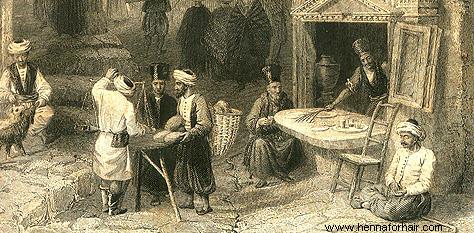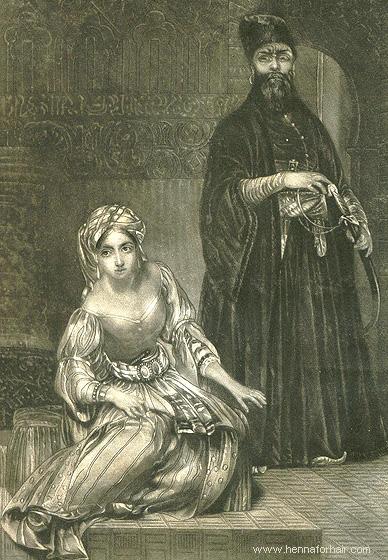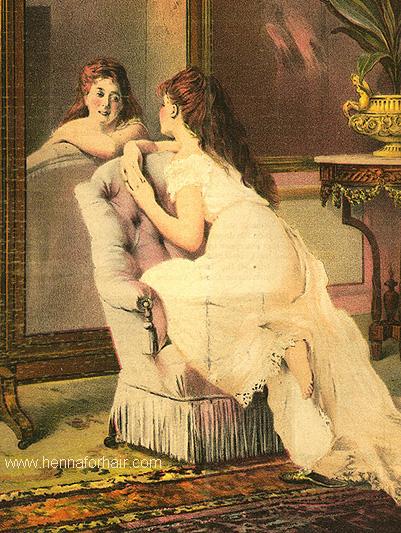At the end of the 19th
century, women of Istanbul and Smyrna used an estimated 15,000 pounds
of henna annually as hair dye. The major producers were Boyadgian,
Sohandgian, Tahiz, and Karagheosian, who had shops in the main bazaar.
Most of their henna hair dye products were “rastik”, or mixtures of
henna and other materials, to produce a range of colors. The
formulae of their rastiks were closely guarded secrets, but were
compounds of oak gall, henna, alum, sugar, iron sulphate, copper
sulphate, antimony, madder, buckthorn, and fragrance.  As European counties increased their trade relations with Turkey through colonial expansion, henna was exported to Europe along with carpets, tea, and other luxury goods. “Oriental Women”, from the harems of the Middle East, were perceived in the European imagination as mysterious, sensuous, a combination of infinitely alluring and untouchable, as well as simultaneously barbaric and opulent. European and American women devoured "pulp fiction" stories of the exotic east, shocked, titillated, and desirous of a life that was filled with lust, luxury, passion ... and most everything else that they found lacking in their own lives.  Fair virgin trembling before her cruel captor (imminent sexual encounter implied) When diplomats and travelers went abroad, they often took a painter or photographer with them to record the exotic world, which they did … richly embellished with their own attitudes and fantasies. The opulent (though hardly accurate) depictions of Turkish harem life by Ingres and others caught the imagination of Europeans in the 19th century just as science fiction motion pictures catch the imagination of people now, and created demand for products. Turkish merchants were happy to supply the goods European women felt might make them as desirable and exotic as they believed Oriental women must be. One of the products shipped out was henna. Daring European women began to dye their hair with henna by the second half of the 19th century, and experimented with dying their nails and soles to take on some of the glamour they believed was the life of Middle Eastern women. They lolled on Turkish and Persian carpets, surrounded themselves with Orientalia and assumed exotic self-absorbed postures.*  This European woman of the 1880's has hennaed her hair, her soles, and her nails, and is admiring the exotic results. She also has an imported Turkish carpet, exotic urn and plant. When “daring, fashion forward” European and American women went to purchase these Oriental wonders: they were sold boxes of “black henna”, “red henna” “blonde henna” and “neutral henna”. These were “rastik”, henna, indigo, and cassia. The westerners had no idea what was in the boxes, nor was precise labeling required at that time. There were no injuries reported, just beautiful results. The term “to henna” became synonymous with dying one’s hair, no matter what plant was used. “Henna” was the universal term for hair dye at the beginning of 1900, and was the safest, most widely used, most reliable hair dye until the technology of para-phenylenediamine dye was transferred from the textile and fur industry into the cosmetic industry in the late 1930’s. Resources: 19th century scrapbooks of magazine clippings, sources unknown. Zanni Chemist and Druggist, 1925, vol, 103, p 217 *Editor's note: if this seems odd to you, think "Trekkie Convention" |